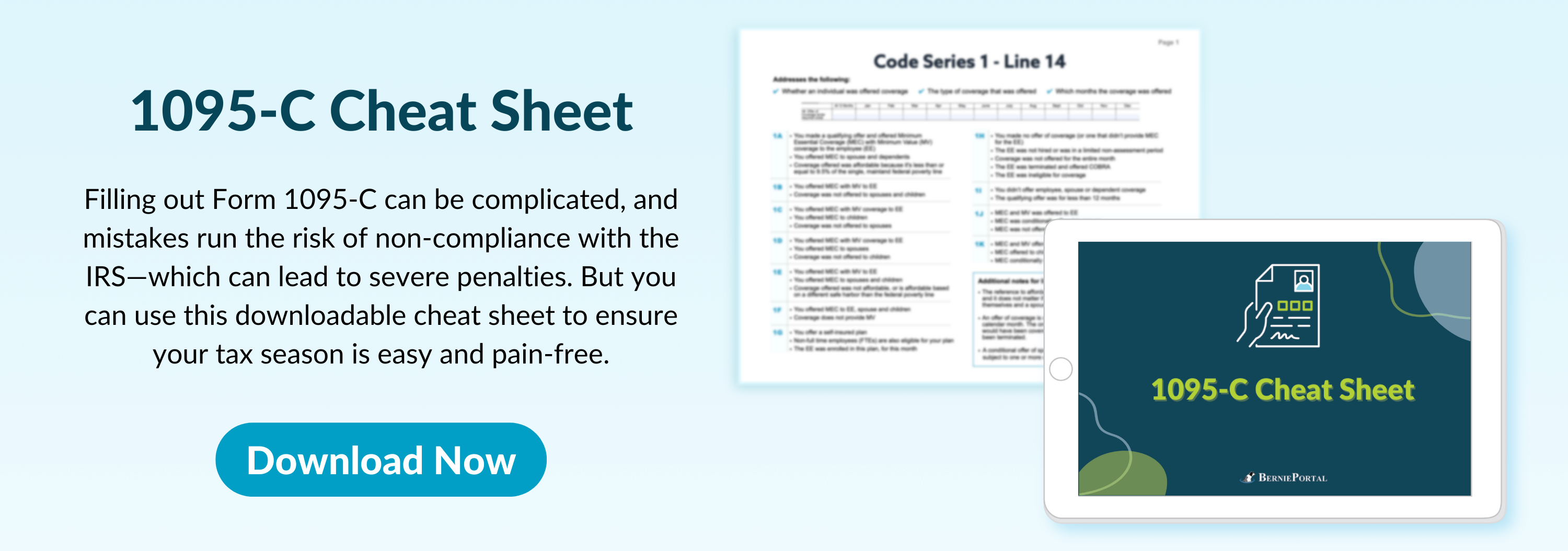
Written by
Aidan Farrish
Aidan is an aPHR-certified writer on the marketing team at BerniePortal. She writes about HR, healthcare, and benefits.
HR's Guide to Form 1095-C Compliance and Best Practices

Form 1095-C compliance isn't always easy, but it definitely doesn't have to be difficult. From what it is and how reporting works to updates for the new year and common employee FAQs, find out what HR and employers need to know about Form 1095-C.
What Is Form 1095-C?
The Affordable Care Act (ACA) requires all Applicable Large Employers (ALEs) to offer full-time employees qualifying healthcare coverage. (An ALE is defined as an organization with 50 full-time employees or full-time equivalents.) Beginning in the 2015 tax year, employers with more than 50 full-time employees (or full-time equivalents) became required to report certain health insurance information to the IRS.
All ALE organizations are required to complete Forms 1094-C and Form 1095-C to indicate to the IRS whether the employer owes a penalty for not offering qualifying coverage. In addition, Form 1095-C helps the IRS determine which employees were eligible for subsidies for individual health insurance during the year.
One important note: A 1095-C must be filed for every person employed that year, not just current employees.
What Is Form 1094-C?
Form 1094-C can be thought of as a cover sheet for all of an organization’s Form 1095-C documents.
Every organization must file one 1094-C form per tax ID. It requires information such as the number of people employed and how many 1095-C forms are being filed. Additionally, employers file the form only with the IRS and do not distribute it to employees.
The History of Form 1095-C
Form 1095-C is a product of the Affordable Care Act, sometimes known as Obamacare. However, the history behind American healthcare is much more complex than the simple introduction of a new reporting form.
To learn more about Form 1095-C's origins, review the following HR Party of One episode:
How Does Full-Time Equivalency (FTE) Impact Form 1095-C?
Full-time equivalency (FTE) represents an employee’s total hours worked divided by the number of compensable hours in a full-time schedule during a fiscal year. It applies to both full-time and part-time teammates.
Employers are encouraged to use a calculator to determine their ALE status or use the following steps:
1. Calculate the number of full-time employees (FTE) per month.
Add all the FTEs for each month together to get a subtotal.
The IRS defines a full-time employee as someone who works 30 hours per week or 130 hours per month. Full-time equivalency (FTE) represents an employee’s total hours worked divided by the number of compensable hours in a full-time schedule during a fiscal year.
2. Calculate the number of hours worked by non-FTEs per month.
Divide this number by 120 to determine the number of full-time equivalents. Add all months together to get a subtotal.
3. Add the two subtotals together.
4. Divide the total by 12.
5. If the total is less than 50, you are NOT an ALE. If the total is greater than 50, you ARE an ALE.
Updates to Form 1095-C in 2020
In the fall of 2020, the IRS released final versions of Forms 1094-C and 1095-C. While the former remained mostly unchanged, a few key updates were made to the latter. Now, several new codes (1L through 1S) are included to describe the affordability of coverage that an employer offers to employees, their spouses, and their dependents. This specifically applies to costs associated with individual coverage HRAs—otherwise known as ICHRAs.
Updates to Form 1094/1095-C Filing in 2024
Forms 1094-C and 1095-C must be e-filed if an employer is filing 10 or more forms total for the year. This dramatically impacts employers that filed tax returns or other compliance forms on paper. See what has changed.
2024 ACA Form Deadlines
For filing in 2024, applicable large employers must furnish and file forms by certain dates. To furnish a form is to give a copy to the employee, and to file it is to submit it to the governing body, which in this case is the IRS.
Form 1095-C Furnishing Deadline
Furnish the 1095-C forms to employees by March 4, 2024. To furnish this form correctly, employers and/or HR professionals must mail it to the correct address of the employee, or ensure the recipient receives it electronically.
Knowing the correct way to furnish a form (and avoid non-compliance) can be tricky. You can use a benefits administration and payroll system, part of an all-in-one HRIS, to ensure these forms are sent to the right address, and have accurate information.
Form 1095-C Paper Filing Deadline
File the 1095-C forms to the IRS on paper by February 28, 2024.
Form 1095-C E-Filing Deadline
File the 1095-C forms to the IRS electronically by April 1, 2024. To e-file this form correctly, employers and/or HR professionals must first ensure all information is correct. There are three options to choose from to streamline the e-filing process and triple-check that information is accurate.
State-Specific ACA Compliance Filing Deadlines
Some states have individual filing mandates ordering individuals to retain health coverage. Those individuals have a separate form, the 1095-B, rather than the employer-sponsored healthcare form 1095-C.
| State | Deadline |
| Massachusetts | January 31 |
| New Jersey | April 1 |
| California | April 1 |
| Rhode Island | April 1 |
| District of Columbia | April 30 |
Employers offering minimum essential coverage may also be required to fill and file 1095-B forms. Employers who are ALE status and offer "self-insured" plans must fill and file 1095-B and 1095-C, which they can combine the information into 105-C forms.
How to File Form 1095-C
Organizations that file more than 10 Form 1095-Cs must file electronically. This is a new requirement beginning in the tax year 2024. Organizations with fewer than 10 can file by paper, but in general, electronic is an easier process.
So how do you file electronically, and what vendors are available to manage this process?
Option 1: Payroll companies
Payroll companies are used to filing tax forms, so that’s a benefit here. However, because Form 1095-C requires benefits information, HR or the benefits broker becomes the involuntary middleman. This circumstance can create tension and slow down the process.
Option 2: Standalone vendors
Standalone vendors are vendors who exclusively provide Form 1095-C solutions. Because standalone vendor 1095-C solutions act independently of other systems, they must pull benefits information from different sources.
Depending on the system, the software may generate PDFs of the IRS forms, provide some reporting functionality, and e-file the documents as well as mail them to employees. These systems are often available through tax preparation providers.
When the Form 1095-C requirements were new—they became mandatory for the 2015 tax year—and employers were in a time crunch to become compliant, a standalone strategy may have made sense. However, most groups have realized that manually pulling coverage data is a lot of work on an annual basis, especially if you have this information already compiled in a benefits administration platform.
A better option is to use a Form 1095-C solution that is tied to a benefits system, which already stores all the relevant information.
Option 3: Benefits administration
Benefits administration software providers are the most logical platforms to use when filing 1094-C/1095-C forms. These providers are an obvious choice because benefits administration technology already hosts all the information necessary to complete both Form 1094-C and 1095-C—and many also handle mailing and e-filings.
Ultimately, administrators will want to consider how much of their time is currently spent on the 1095-C process and whether that can be minimized by using a system that is connected to their benefits platform.
For more information on filing and distributing Form 1095-C, consult the BerniePortal blog.
Possible Form 1095-C Non-Compliance Penalties
According to the IRS, the penalty for failure to file applicable ACA information is generally $100 for each return for which such failure occurs. The total penalty imposed for all failures during a calendar year cannot exceed $1.5 million.
The fine for not complying with the employer mandate is even higher. There are two kinds of penalties: the “sledgehammer penalty” (or "A" penalty)—which applies to employers who fail to offer any coverage—and the “tackhammer penalty” (or "B" penalty), which is applied to employers who offer a plan that doesn’t meet ACA standards, such as providing minimum value.
The IRS announces increased panelties nearly every year. 2024 penalties for failure to comply with ACA fiing requirements are as follows:
- The sledgehammer penalty in 2024 is $2,970 per year for each full-time employee, excluding the first 30 employees, if one full-time employee receives a federal premium subsidy for marketplace coverage.
- The tack hammer penalty in 2024 is the lesser of $4,460 per full-time employee receiving a subsidy, minus the first 30.
Form 1095-C Individual Mandate Requirements
Beginning in 2019, the federal penalty for failing to carry comprehensive coverage in the previous tax year became $0. While the federal penalty is $0, some states have chosen to implement additional penalties:
- Massachusetts: The penalty is calculated at 50% of the cost of the lowest-cost plan that could have been purchased. There is no penalty if your income is up to 150% of the poverty level.
- New Jersey: The maximum penalty will be based on the average cost of a bronze plan in the state of New Jersey.
- Rhode Island: Rhode Island presents income tax penalties for non-compliance with the 2020 individual mandate. The Rhode Island government website provides more information.
- Washington, D.C.: The maximum penalty will be based on the average cost of a bronze plan in DC.
- Vermont: Launched in 2020, Vermont’s individual mandate requires residents to maintain minimum essential coverage. However, there is no penalty for non-compliance. Instead, this information is compiled and used by the state to provide targeted outreach to help applicable residents enroll in appropriate and affordable coverage.
Additional Resources
You can stay informed, educated, and up to date with important HR topics using BerniePortal’s comprehensive resources:
- BernieU—free online HR courses, approved for SHRM and HRCI recertification credit
- BerniePortal Blog—a one-stop shop for HR industry news
- HR Glossary—featuring the most common HR terms, acronyms, and compliance
- Resource Library—essential guides covering a comprehensive list of HR topics
- HR Party of One—our popular YouTube series and podcast, covering emerging HR trends and enduring HR topics

Written by
Aidan Farrish
Aidan is an aPHR-certified writer on the marketing team at BerniePortal. She writes about HR, healthcare, and benefits.
Related Posts
Part-time work is becoming increasingly common in today’s workforce—especially for...
As you know, healthcare and benefits can be complicated, which can make the enrollment...
With the deadline for filing and distributing 1095-C forms approaching, staying...
A strong paid time off (PTO) policy helps retain current talent and attract prospective...








Submit a Comment